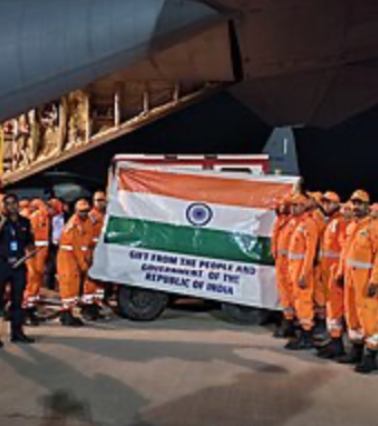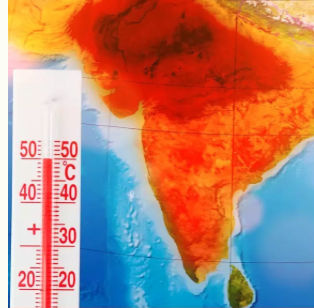Daily Current Affairs | March 29 2025
Important Topics from Current Affairs : 1) Operation Brahma 2) Heatwave in North India 3) Kamikaze Anti-Tank Drone 4) National Gene Bank
Jumbo IAS
3/29/20254 min read
1) Operation Brahma
The massive earthquake(7.7 magnitude) that devastated Myanmar and neighbouring Thailand killed over 1,600 people and caused widespread destruction.
Recently, India initiated its relief and rescue efforts in the country under the banner 'Operation Brahma'.


About the Operation
It is India's humanitarian mission launched in response to the devastating 7.7-magnitude earthquake that struck Myanmar on March 28, 2025.
National Disaster Response Force (NDRF) deployed an 80-member team.
Indian Army dispatched a specialized 118-member medical team from the elite Shatrujeet Brigade Medical Responders.
Two Indian naval ships, INS Satpura and INS Savitri, were dispatched.
Indian Air Force is using C-130J aircraft.
2) Heatwave in North India
The India Meteorological Department (IMD) has forecast 10–12 heatwave days in northwest India this summer, nearly double the usual average of 5–6 days.


Heatwaves
Heat wave is considered if maximum temperature of a station reaches at least 40ºC or more for Plains, at least 30ºC or more for Hilly regions and 37ºC for coastal regions.
Based on Departure from Normal :
Heat Wave: Departure from normal is 4.5ºC to 6.4ºC
Severe Heat Wave: Departure from normal is >6.4ºC
Based on Actual Max Temperature
Heat Wave: When actual maximum temperature ≥ 45ºC
Severe Heat Wave: When actual maximum temperature ≥47ºC.
If above criteria is met at least in 2 stations in a Meteorological sub-division for at least 2 consecutive days.
Causes & Impact
Causes :
Climate Change - Rising global temperatures and El Niño events intensify heatwave frequency and duration.
Urban Heat Island - Concrete-dominated cities are 4 to 5°C hotter than rural areas due to heat absorption.
Humidity - Coastal areas face “wet bulb” threats where high humidity makes 35°C feel like 40°C.
Impact :
Human Health - Can cause heat stroke, dehydration, sleep disturbances, heat anxiety and even death.
Ecological Threat - Increased evaporation leads to dry conditions which increase the threat of forest wildfires.
Agriculture - Heatwaves during flowering stages harm crop productivity.
Water Stress - Increased evaporation leads to dry rivers, lakes and other freshwater resources.
Govt. Steps
Heat Action Plans : Coordinated by National Disaster Management Authority(NDMA) in 23 states to offer early warnings and health advisories.
Advance Warnings by IMD : Advance warnings issued via Seasonal Heat Outlooks.
Cooling Centres Pilot Projects : Initiated in Ahmedabad and Nagpur, offering public spaces to cool down.
Urban Cooling Measures : Some cities promote green roofs, water kiosks, and shaded shelters.
Shifting Work Hours : Labour departments issue circulars to limit midday work hours.
Way Forward
Integrate HAPs into Master Plans: Make heat resilience part of city development frameworks.
Expand Green Infrastructure: Promote urban forests, reflective rooftops, and water conservation systems.
Strengthen Data Systems: Create a unified national database for heatwave mortality and hospitalisations.
Community Awareness Programs: Launch heat literacy drives and targeted awareness campaigns.
Climate-Smart Infrastructure: Retrofit buildings with passive cooling, improve electricity access and backup systems.
3) Kamikaze Anti-Tank Drone
Drawing lessons from the rising effectiveness of armed FPV drones against tanks in the Ukraine-Russia war, the Indian Army has developed its First-Person View (FPV) drone equipped with an impact-based, kamikaze-role anti-tank munition — a first-of-its-kind project in the force.


About the Drone
A low-cost, First-Person View (FPV) drone equipped with impact-based anti-tank munition developed for kamikaze-style tactical warfare.
Developed by Indian Army in collaboration with DRDO’s Terminal Ballistics Research Laboratory (TBRL), Chandigarh.
Purpose - To enhance India’s capability in modern drone warfare through indigenous, cost-effective, and precision-strike systems.
Special Features
First Person View (FPV) - Operated using FPV goggles that stream live visuals, providing real-time battlefield awareness and control.
Kamikaze Attack - Single-use drone carrying impact-explosive payloads designed to destroy armoured targets like tanks.
Safety - Prevents accidental detonation; payload can only be activated via pilot’s radio controller under controlled conditions.
Cost - Estimated cost of ₹1.4 lakh per drone, with 5 inducted and 95 more being procured.
Assembled at the Rising Star Drone Battle School, with over 100 units fabricated by March 2025 for training and trials.
4) National Gene Bank
The central government has announced the establishment of the second National Gene Bank (NGB) as part of its efforts to ensure long-term food and nutritional security.
This initiative, which falls under the “Investing in Innovations” theme of the Union Budget 2025-26, aims to conserve 10 lakh crop germplasm for the future.


About Gene Bank
A repository of plant genetic material (seeds, tissue, pollen) designed to conserve biodiversity and protect crop varieties from extinction.
Managed by ICAR’s National Bureau of Plant Genetic Resources(NBPGR).
Uses cryogenic storage, long-term seed preservation chambers, DNA fingerprinting, and digital databases for germplasm management.
India’s first gene bank was established in 1996 at ICAR-NBPGR headquarters, New Delhi.
Benefits of a Gene Bank
Biodiversity Conservation - Gene banks safeguard plant species from extinction by storing seeds, pollen, and plant tissues, ensuring their availability for future use.
Food Security - By conserving crop diversity, gene banks help ensure food security for future generations, particularly in the face of climate change and other challenges.
Supports Plant Breeding - The stored germplasm is a valuable resource for plant breeders, helping them to develop new and improved crop varieties with enhanced traits.
India’s Agricultural Heritage - Gene banks help preserve India's native, traditional, and rare plant varieties, contributing to the country's rich agricultural heritage.
The establishment of a second National Gene Bank strengthens India's position as a leader in global biodiversity conservation.


